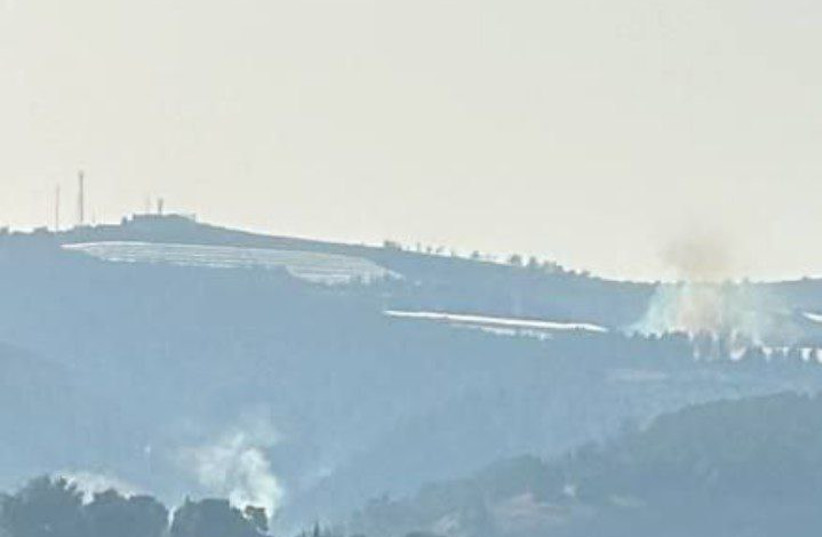“Hezbollah’s precision strikes on Hurfeish reveal a deadly evolution in their tactics. What does this mean for Israel’s defenses?
SETH J. FRANTZMAN JUNE 5, 2024 21:24

The attack on Hurfeish on Wednesday is a dangerous escalation. The wounding of numerous people illustrates how Israel’s enemies seek to improve their weapons and also test different types of methods of attack.
In order to understand how this has unfolded, we need to understand what the adversary has up its sleeve. Hezbollah’s recent escalation against Israel is part of a campaign of almost eight months in which it has used rockets, missiles, and drones to attack Israel. By April, six months into the war in Gaza and after six months of Hezbollah attacks, the total number of projectiles launched by Hezbollah had reached 3,000. Today, the number has likely reached up to 4,000.
However, Hezbollah’s goal these days is not just to launch rockets. Rockets are a statistical weapon, like artillery, meaning that you launch a bunch of them and you hope that some of them hit the target. Hezbollah’s arsenal of rockets may be 150,000 projectiles but a lot of these weapons are simple older “dumb” rockets. These types of weapon systems don’t win wars. In fact, rockets are primarily good for harassing fire or attacking civilians.
Hezbollah’s arsenal getting deadlier
Hezbollah has improved its arsenal in recent years. It acquired precision-guided munitions and it has a large number of anti-tank missiles, as well as drones. It’s important to understand that when Hezbollah carries out its attacks these days it is using a number of precision weapons.
The precision weapons allow Hezbollah to strike exactly what it wants to strike. It also can follow up certain types of attacks by using a mix of weapons. For instance, it could use dumb rockets to set off sirens in one place and then use precision drones to strike a certain area where it has monitored people seeking shelter. Hezbollah published videos of these types of incidents so it is no longer hiding what it is up to.

An image taken from Hezbollah’s Telegram channel purporting to show the Lebanon-based terror organization’s attack on Hurfeish. June 5, 2024. (credit: Hezbollah Telegram)
Hezbollah also uses language in its statements distributed to pro-Iranian media such as Al-Mayadeen to explain how it uses certain types of weapons. The type of language in Hezbollah statements indicates the terrorist group is carefully choosing the mix of weapons it uses. This is a deadly cocktail.
IT ILLUSTRATES that Hezbollah is trying to test Israel’s response and Israel’s defenses. For instance, Hezbollah has frequently targeted Iron Dome sites, according to Hezbollah’s own claims. It has also launched drones increasingly out to sea in the Mediterranean and then had the drones turn back for the coastline, heading toward Acre or Nahariya. Hezbollah has said it is trying to target a site of Israel’s Rafael Advanced Defense Systems, the maker of Iron Dome. The site is on the coast of Israel and this is linked to Hezbollah’s launching of drones out to sea.
Furthermore, Hezbollah often targets what it says is an Iron Dome site in the Hula Valley. It has also targeted an Israeli surveillance balloon near Golani junction, far from the Lebanon border. It has also targeted Israeli communication towers and the air traffic control base on Mount Hermon.
Hezbollah also says it has targeted Israel’s Northern Command base in Safed and the Gibor Base of the 769 brigade in Safed, as well as the headquarters of the 91st division and the Biranit camp near the Lebanese border. In each case, Hezbollah resorts to weapons it thinks will have the most impact. Sometimes it has resorted to Burkan heavy rockets, which are not precise but cause a lot of damage. In other cases, such as targeting IDF soldiers in Arab Al-Aramshe last month, Hezbollah used several projectiles, including drones.
Hezbollah claimed it targeted an area near Al-Kosh on June 5 using a “swarm” of drones. It says it targeted IDF soldiers near the Druze village Hurfeish. “The Israeli media reported that Hezbollah targeted a gathering of soldiers in Hurfeish, and that when the Army’s rescue and ambulance forces arrived, the place was targeted for the second time, confirming that the bombing of the base was carried out using missiles and drones,” Al-Mayadeen said. This is how Hezbollah launders claims through Israeli media and then back to pro-Iran media in Lebanon.
Sirens did not sound in Hurfeish prior to the attack. Al-Mayadeen ascribes this to “Hezbollah’s success in targeting the army’s radar system and the Iron Dome batteries.” Hezbollah is also openly expanding its attacks, threatening areas beyond the border. Hezbollah knows that the communities on the border have been evacuated since October. It is now escalating against Hurfeish, Nahariya, and Acre, as well as Katzrin in the Golan. This is calculated and not random.
Hezbollah is now trying to figure out what weapons mix may be used against Israel’s defenses. The goal for Hezbollah is for it to do what the Houthis did between 2015 and 2020 fighting Saudi Arabia. The Houthis were a test-bed for Iran and Iranian weapons such as ballistic missiles, cruise missiles and also drones. Hezbollah is now the test bed and this is part of a larger Iranian strategy in the region to test weapons against Israel. Hezbollah is testing them and the tests are becoming increasingly dangerous and deadly.
Content retrieved from: https://www.jpost.com/israel-news/defense-news/article-805135.